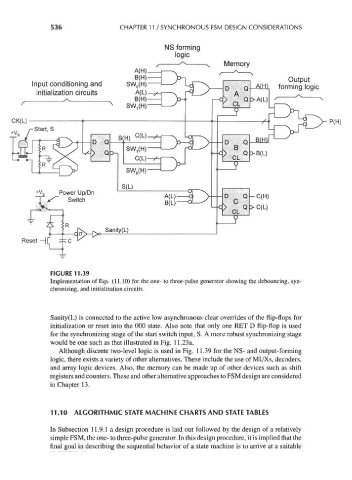Page 566 - Engineering Digital Design
P. 566
536 CHAPTER 11 / SYNCHRONOUS FSM DESIGN CONSIDERATIONS
NS forming
logic
Memory
Input conditioning and SW 0(H) 1 ' U~~X fcI] Ami formhg togic
initialization circuits
P(H)
+v s Power Up/Dn
~T~ S~ Switch
>C(L)
FIGURE 11.39
Implementation of Eqs. (11.10) for the one- to three-pulse generator showing the debouncing, syn-
chronizing, and initialization circuits.
Sanity(L) is connected to the active low asynchronous clear overrides of the flip-flops for
initialization or reset into the 000 state. Also note that only one RET D flip-flop is used
for the synchronizing stage of the start switch input, S. A more robust synchronizing stage
would be one such as that illustrated in Fig. 11.23a.
Although discrete two-level logic is used in Fig. 11.39 for the NS- and output-forming
logic, there exists a variety of other alternatives. These include the use of MUXs, decoders,
and array logic devices. Also, the memory can be made up of other devices such as shift
registers and counters. These and other alternative approaches to FSM design are considered
in Chapter 13.
11.10 ALGORITHMIC STATE MACHINE CHARTS AND STATE TABLES
In Subsection 11.9.1 a design procedure is laid out followed by the design of a relatively
simple FSM, the one- to three-pulse generator. In this design procedure, it is implied that the
final goal in describing the sequential behavior of a state machine is to arrive at a suitable

